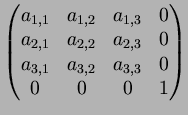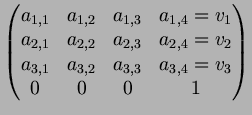Next: 4.3.2 Perspective Projection Up: 4.2 Transformations Previous: 4.2.5 Angle-Preserving Mappings
Beside euclidean motions, conformal linear mappings we have discussed also scaling, where we shrink or stretch the coordinates according to some factors. Scaling can be described by diagonal matrices with the proportionality factors as eigenvalues.
Another kind of mapping of interest is shearing:

We would like to have a common formula for all these transformations.
For this we embed
![]() into
into
![]() via
via
![]() .
Then a translation by the vector
.
Then a translation by the vector
![]() can be written as
can be written as



matrix a11, a21, a31, a12, a22, a32, a13, a23, a33, a14, a24, a34Note that this is transposed relative to the mathematical version.
An advantage of this description is to be able to describe perspective (no-linear) projections in the same way, see (4.3.2).
Proof.
![]() Because of
Because of
![]() we have
we have
![]() and thus
and thus
![]() .
.
![]() We have
We have
![]() . For
. For
![]() we get
we get
![]() , and hence
, and hence
![]() . Furthermore
. Furthermore
![]() and
and
![]() for
those
for
those ![]() .
I.e.
.
I.e.
![]() .
.
Conversely, let
![]() . Then
. Then ![]() with
with
![]() and
and
![]() .
Thus
.
Thus
![]() , i.e.
, i.e. ![]() and
and
![]() .
By orthogonalization we get the desired equation.
.
By orthogonalization we get the desired equation.
![]() Since
Since
![]() and
and
![]() with
with
![]() and
and
![]() we have
we have
![]() since
since
![]() .
.
![]()
One can even project on some plane orthogonal to ![]() but with rays parallel to some
other vector
but with rays parallel to some
other vector ![]() .
.
ARRAY(0x8dab5ac)
Andreas Kriegl 2003-07-23